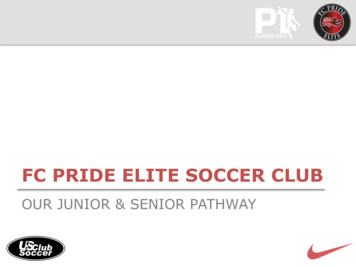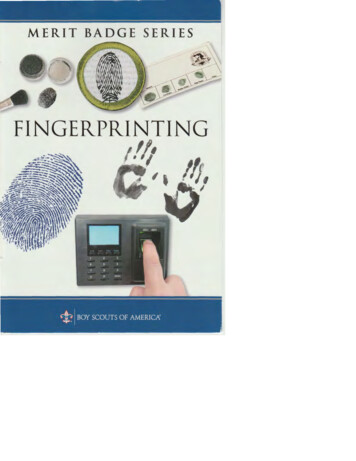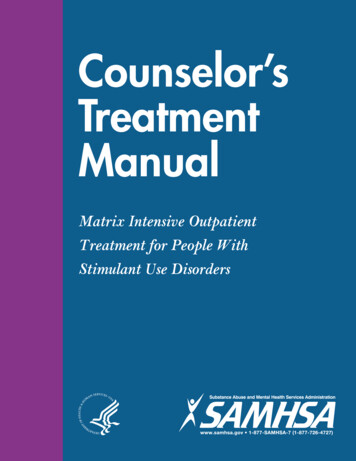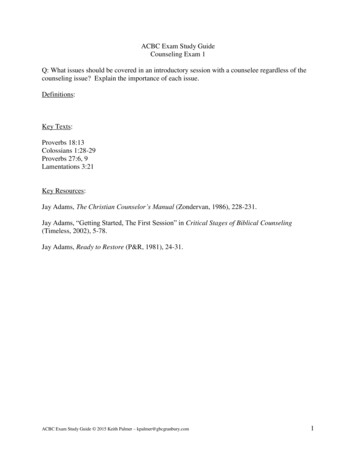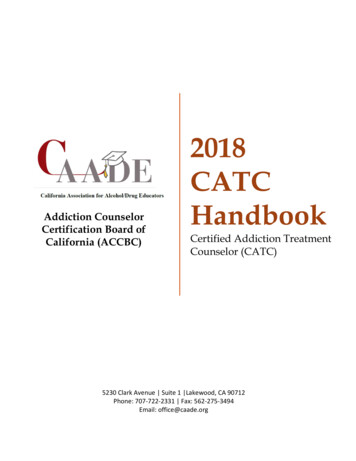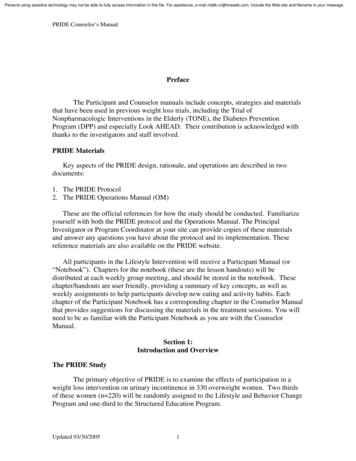
Transcription
Persons using assistive technology may not be able to fully access information in this file. For assistance, e-mail niddk-cr@imsweb.com. Include the Web site and filename in your message.PRIDE Counselor’s ManualPrefaceThe Participant and Counselor manuals include concepts, strategies and materialsthat have been used in previous weight loss trials, including the Trial ofNonpharmacologic Interventions in the Elderly (TONE), the Diabetes PreventionProgram (DPP) and especially Look AHEAD. Their contribution is acknowledged withthanks to the investigators and staff involved.PRIDE MaterialsKey aspects of the PRIDE design, rationale, and operations are described in twodocuments:1. The PRIDE Protocol2. The PRIDE Operations Manual (OM)These are the official references for how the study should be conducted. Familiarizeyourself with both the PRIDE protocol and the Operations Manual. The PrincipalInvestigator or Program Coordinator at your site can provide copies of these materialsand answer any questions you have about the protocol and its implementation. Thesereference materials are also available on the PRIDE website.All participants in the Lifestyle Intervention will receive a Participant Manual (or“Notebook”). Chapters for the notebook (these are the lesson handouts) will bedistributed at each weekly group meeting, and should be stored in the notebook. Thesechapter/handouts are user friendly, providing a summary of key concepts, as well asweekly assignments to help participants develop new eating and activity habits. Eachchapter of the Participant Notebook has a corresponding chapter in the Counselor Manualthat provides suggestions for discussing the materials in the treatment sessions. You willneed to be as familiar with the Participant Notebook as you are with the CounselorManual.Section 1:Introduction and OverviewThe PRIDE StudyThe primary objective of PRIDE is to examine the effects of participation in aweight loss intervention on urinary incontinence in 330 overweight women. Two thirdsof these women (n 220) will be randomly assigned to the Lifestyle and Behavior ChangeProgram and one-third to the Structured Education Program.Updated 03/30/20051
PRIDE Counselor’s ManualGoals of the Lifestyle and Behavioral InterventionThe study-wide goals of the Lifestyle intervention are to:1) induce and maintain a mean reduction in initial weight of at least 7%2) Increase physical activity to a mean of at least of 200 minutes per weekWeight Loss GoalThe study goal of achieving a minimum mean loss of 7% of initial weight wasselected because it is believed to be safe, effective, and achievable. Individualparticipants will be instructed to aim for a loss of 10% or more of initial weight, thegoal for weight reduction also recommended by an expert panel from that National HeartLung and Blood Institute. This 10% goal is appealing because it is easily grasped byparticipants. Simply take the first two numbers of the current weight, reading from leftto right; that is a 10% loss. Thus, a 10% loss from a starting weight of 230 lb would be23 lb, the first two numbers of 230.Individual participants are encouraged to lose as much weight as they can,provided that they lose at a safe rate (i.e., an average of 1-2 lb a week) and do notreduce below a body mass index of 21 kg/m2 (i.e., normal weight). Participants shouldnot be discouraged from losing more than 10% of initial weight. The greater the numberof participants who lose 10% or more of initial weight, the more likely we will be to meetthe study wide-goal of achieving a mean loss of at least 7% of initial weight. In addition,studies indicate that larger weight losses are associated with greater improvements inobesity-related health complications, as well as with the maintenance of larger weightlosses at follow-up.We know from previous studies that many participants, despite their best efforts,and yours, will not reach the 10% weight loss goal and that a minority will not reach eventhe study-wide goal of at least a 7% reduction in initial weight. These individuals willneed your extra support and encouragement. In all cases, they should be congratulated fortheir accomplishments, rather than being criticized for not reaching the weight goal.Physical Activity GoalThe PRIDE physical activity goal is to reach and maintain a minimum of 200minutes of activity per week (by the end of the first 6 months). The recommendedactivity will consist of brisk walking, although participants will be allowed to select otheraerobic activities. Only bouts of activity 10 minutes or longer will count toward the 200minute a week goal. Participants also will be encouraged to increase their lifestyleactivity (throughout the day) by using stairs rather than elevators, parking further awayfrom mall entrances, and reducing reliance on energy-saving devices. Increases inlifestyle activity will be tracked by the use of pedometers. Participants’ eventual goal willbe to walk 10,000 steps or more per day. This total represents the combination of boththeir planned activity (i.e., 200 minutes a week) and their increased lifestyle activity.Updated 03/30/20052
PRIDE Counselor’s ManualAs with the weight loss goal, participants will be encouraged to exceed theactivity goals described above. This is particularly true of individuals who enter the studyalready exercising 200 minutes a week. We hope such individuals will increase theiractivity well beyond 200 minutes a week.Increased physical activity will be critical for helping participants maintain theirweight loss; it is the single best predictor of weight loss maintenance. Increased activityalso is associated with a reduced risk of cardiovascular disease, regardless of whether theindividual is fat or thin.Section 2:Overview of the Lifestyle and Behavioral InterventionDuration and Format of TreatmentAll participants in the Lifestyle Intervention will receive 18 months of intensivetreatment, as described below:Phase I: Weight Loss InductionMonths 1-6: Weekly visits.Phase II: Weight Loss MaintenanceMonths 7-18: Every-other-week visits.Group SessionsThe Lifestyle Intervention will be implemented using a group treatment model.Participants will attend group sessions with 10-20 other participants. The same group of10-20 participants will begin and end treatment together; no new members will beadmitted to the group after the first week or two. This closed group format buildscohesiveness and allow for a structured curriculum in which one week’s lesson builds onthe preceding one. Group treatment provides important social support, an opportunity forparticipants to learn from each other, and a group norm against which participants mayjudge their progress. Group programs have been shown to be as effective, or moreeffective, than individual therapy for weight loss.Dietary InterventionTo induce weight loss, participants who weigh less than 250 lb will be asked toconsume 1200-1500 kcal/d while those weighing more than 250 lb will be prescribed1500-1800 kcal/d. These calorie levels should induce a loss of approximately 1-lb aweek. For participants who do not achieve this rate of loss, levels may be reduced to1000-1200 kcal/d and 1200-1500 kcal/d, respectively. The composition of the diet will beUpdated 03/30/20053
PRIDE Counselor’s Manualconsistent with that recommended by the American Diabetes Association/AmericanDietetic Association.Meal Replacement Plan. In order to help as many participants as possible lose10% or more of initial weight, the Lifestyle and Behavior Change Intervention includesthe use of a meal replacement plan. Meal replacements, in the form of “shakes” (“mealbars” will be discouraged since they taste more like candy and don’t help to shape newbehaviors), help people lose weight by providing portion-controlled servings with aknown energy content. Several studies found that persons who were prescribed mealreplacements lost 1.5 to 3 times as much weight as individuals who were prescribed a dietof conventional foods with the same calorie goal. This is because overweight individualsconsistently underestimate their calorie intake by 40% to 50% when they consume a dietof conventional table foods. (Average-weight individuals also underestimate their intake,typically by 20% or more.) Additional studies found that giving participants structuredmeal plans, which specified the foods they were to eat, significantly increased weight losscompared with having participants consume a self-selected diet.Participants in PRIDE will be encouraged to follow a meal replacement plan forthe first 4 months of the study. The plan combines two daily servings of a mealreplacement (which are generally used to replace breakfast and lunch) with an eveningmeal of conventional foods (or a frozen food entrée combined with fruits and vegetables).After the first 4 months of the program, participants will be encouraged to use mealreplacement products for one meal per day for the remainder of the 18-month program.Participants will be given “checkpons” that they can use to receive free Slim-fastthroughout the weight loss intervention.One of your principal goals as a Lifestyle Counselor will be to encourageparticipants to adhere as closely as possible to the meal replacement plan. This shouldhelp them lose 10% or more of their initial weight. The minority of individuals whochoose not to use meal replacements will be encouraged to follow the PRIDE structuredmeal plan that provides menus of conventional foods for breakfast, lunch, dinner, andsnacks. These menus can be tailored to individual preferences. Persons who decline theuse of these menus will consume a self-selected diet of conventional table foods,consistent with the calorie goals described previously. In either of these last two cases,participants should be encouraged to weigh and measure their food.Please note that Slim Fast calorie and fat contents differ depending on theproduct used (e.g., low carb vs. regular). Therefore, individual food plans should betailored accordingly.Section 3:Guidelines for Implementing the Lifestyle InterventionMultidisciplinary TeamEach group of 10 to 20 participants will be treated by a team of two LifestyleCounselors, preferably with different professional backgrounds. Thus, a registeredUpdated 03/30/20054
PRIDE Counselor’s Manualdietitian might be paired with a behavioral psychologist or an exercise specialist. Thepairing of providers with complementary professional backgrounds should ensure that theteam is optimally prepared to deal with the variety of clinical issues that may arise. Thecommonality among the Lifestyle Counselors is that all will have experience treatingobese individuals, and preferably have conducted a group intervention, similar to thatused in PRIDE.Treatment StandardizationPRIDE is being implemented at 2 clinical sites at (The Miriam Hospital, inProvidence, Rhode Island and at the University of Alabama). Both sites will employ theidentical criteria for selecting participants and the identical outcome measures forassessing participants’ progress. The same uniformity is required in implementing thelifestyle intervention. This uniformity will ensure that all participants receive the sameintensive program of diet and exercise modification that will help them lose 10% or moreof initial weight. Several steps have been taken to standardize the delivery of theLifestyle Intervention. These are briefly described below:1. Counselors’ Manual. This manual provides Lifestyle Counselors detailedoutlines of the topics to be covered in the group treatment sessions. The manual describesthe content of the materials to be discussed, as well as methods of covering the content.For example, participants could learn about the benefits of exercise by having theCounselor simply list these for group members. Alternatively, the Counselor could askthe group, “What do you think are the benefits of exercising?” The latter approach isusually more engaging for participants. Regardless of the approach used, the Counselormust cover the “content” about the benefits of exercise.It is essential that you adhere to the Counselors’ Manual as closely as possible.This will ensure, for example, that participants enrolled in PRIDE in Alabama receive thesame instruction and homework assignments at the 5th week of the program thatparticipants in Rhode Island receive at week 5.2. Central Training. A 2-day training will be conducted prior to starting thePRIDE study that will provide Counselors a detailed review of the Participant andCounselor manuals. This will include examining principles and techniques of behaviorchange, methods to facilitate group interaction, the importance of completing homeworkassignments, and tips for working with challenging participants. Moreover, the trainingwill underscore the importance of adhering to the intervention protocol.Counselors who are unable to attend the Central Training must complete severalsteps prior to treating participants. They must:a) study the Participant Notebook and the Counselor Manual, as well asfamiliarize themselves with the PRIDE protocol and the Operations Manual;Updated 03/30/20055
PRIDE Counselor’s Manualb) work closely with the site’s lead Lifestyle Counselor until the latter believesthat the new interventionist is ready to treat participants. This should include observing asenior Counselor conduct at least 3 consecutive group sessions (with the same group ofparticipants).3. Weekly Staffing Conference. At all sites, lifestyle teams should have a weeklystaff conference that has at least two objectives. The first is to review the treatmentprotocol for the upcoming week to determine if it presents any special challenges.Counselors can share ideas concerning how to cover the topics. This review shouldinclude a discussion of the previous week’s protocol and whether there were anyproblems with its implementation. The second objective of this meeting is to reviewparticipants’ progress. This includes reviewing group members’ success in meetingweight loss and activity goals, as well as their attendance at treatment sessions. This isalso a time to discuss participants who need additional help in reaching the study goals orperhaps in coping with stressors at home or work.4. Conference Calls Conference calls will be held approximately once a month(more frequently at the start of the trial) with the lifestyle counselors at both clinical sitesand investigators, co-investigators, and/or consultants on the study who are experts inbehavioral weight control. These conference calls will be used to discuss upcomingtreatment sessions and to review problem participants.Section 4:Overview of Session MaterialsThis first installment of the Counselors Manual contains detailed outlines forconducting weekly group sessions. A total of 24 session outlines are provided which areto be implemented over 26 weeks. It is anticipated that, because of holidays or inclementweather, treatment sessions would not be held for 2 weeks out of the first 26. Individualsites can schedule the 24 sessions (over 26 weeks) at their discretion.Group sessions have been designed to require a total of 60 minutes. This includes15 minutes before the session to weigh participants, with 45 minutes for the actual groupmeeting.Session OutlinesAll of the session outlines follow the same general format described below. The firstthree items require preparation before sessions begin.1) Objectives:This identifies what the participants will learn during the session.Updated 03/30/20056
PRIDE Counselor’s Manual2) To Do Before Session:This section lists materials you will need to prepare prior to the session.Preparing for the sessions includes, for example, writing name tags for theparticipants, obtaining the necessary audiovisual equipment, and having a basket orbox in which participants can deposit their Keeping Track booklets (in which theywill have recorded their food intake and physical activity).3) Weigh in:Participants should be weighed prior to beginning all group sessions. Those whoare late for group should be weighed after the session. Procedures for weighingparticipants are discussed at the end of this section.4) Welcome and Homework Review:Sessions typically begin by reviewing the completion of homework assignmentsfrom the previous week. This component of the session is essential for evaluatingparticipants’ progress in modifying their eating and activity and for identifyingproblem areas. The Counselor Manual offers suggestions for conducting this weeklyreview but feel free to develop your own format.5) New Topics:Each weekly session introduces a new lesson on some aspect of nutrition,physical activity, eating habits, or cognitive restructuring. These materials includesuggestions for how to present the ideas. You may need occasionally to adjust thesession content to better meet participants’ needs and abilities.6) Homework:At each session, participants are assigned homework to help them acquire theskills described in the new materials. This might include trying to limit activitieswhile eating (e.g., not watching television) or to increase lifestyle activity by usingstairs more often. Each week, participants also will record their food intake andphysical activity in their Keeping Track booklets. Regular self-monitoring is thebackbone of the lifestyle intervention. It is the first priority if participants do not havetime to complete all of their homework assignments.7) Close:This section contains information on how to end the session and any issues relatedto activities of the next scheduled session.Updated 03/30/20057
PRIDE Counselor’s ManualFormat of the Session OutlinesEach weekly outline describes the structure of the session and the content of thematerials that you should cover. In addition, suggestions are provided on how to deliverthe materials, typically in an interactive fashion by asking participants questions.The first five sessions of the Counselors’ Manual also provide narrativedescriptions of what you might say to participants in conducting the session. Thesenarratives are offered as examples, particularly for Counselors who are new toconducting weight loss groups. You are not expected to use the specific words orexamples provided in the narratives. Narrative material in the first five sessions ispresented in italics.Covering the Session TopicsThe session outlines provide a blueprint for conducting the group sessions. Yourchallenge as a Lifestyle Counselor is to bring these blueprints to life by leading sessionsthat are productive, engaging, and enjoyable for participants. This will require you to bethoroughly familiar with the content of the materials so you can focus on delivering theconcepts and on participants’ reactions to them. Suggestions for leading effective groupsare discussed in another chapter of this manual.One-week window. Inspection of the first 24 session outlines reveals that theyvary in length and in the number of topics covered. You may feel that some sessions havetoo much material and others too little. In cases in which you do not have time to coverall the topics in a session, you have two options. The first is to cover the omitted materialin the following week’s session or, potentially, to cover it the week before if you areaware of the time crunch in advance. Thus, you will have a window of plus or minus( 1) one week for covering the topics in the manual.The second option involves prioritizing the topics in each session, which you shoulddo routinely in preparing for group meetings. Always identify the most important topicsto address in the session and make sure they are covered. You can summarize in a fewsentences information on topics of secondary importance, invite participants to review thecorresponding materials in the Participant Notebooks, and have them bring questions tonext week’s session.Measuring Participants’ Body WeightFor participants, body weight is likely to be a key outcome measure of theintervention. It also is a key study goal. It is recommended that Lifestyle Counselorsthemselves weigh participants rather than having a research assistant or medicaltechnician perform this task. The weigh-in gives you a look at the participant’s progressduring the week. Particularly if the participant has not lost weight, a 1-minute interactionat the scale can alert you to any difficulties that participants are having, whether withtheir eating and activity habits or with stressors at home or work. You may decide toUpdated 03/30/20058
PRIDE Counselor’s Manualencourage participants to discuss their difficulties in the group session or to speak withyou after the meeting. By weighing participants, you begin the session informed of eachparticipant’s status.Procedures for weighing. Participants should be weighed on a digital scale withshoes removed. Every effort should be made to weigh participants under the sameconditions from week to week (i.e., same time of day, wearing similar clothing, shoesremoved, etc.). Ask participants to stand still in the middle of the scale platform withhead erect and eyes looking straight ahead. Record the weight in pounds to the decimalpoint as indicated on the digital display. Ask the participant to step off the scale andcheck that the digital display returns to zero. Record the weight on the group weight losschart.Place for weighing. Patients should be weighed in private to allow you and theparticipant to discuss weight or related issues. If a private room is not available, a screenmay be used to enclose the scale. You will need to speak in a whisper to maintain theparticipant’s privacy.Recording weights. Weights should be recorded on 3 documents- the Interventionform that is faxed to the Coordinating Center, the clinical site’s local chart, and the chartwhich the patient retains.Responding to Weight Change.Some participants become nervous when being weighed. A few will remove alljewelry, their belt, and other non-essential clothing in hopes of showing a weight loss. Ithelps for Counselors to maintain a calm, low-key attitude during the weigh-in; it shouldserve as a model for participants.Participants also may display a range of emotional reactions in response to theirweight change. A large weight loss is often greeted by elation, while a weight gain (or nochange in weight) is often met by disappointment or frustration. You probably have yourown ways of responding to participants’ weight change and their emotional reactions.The following suggestions also may be helpful:Let participants respond first. After you have told a participant her weight change,allow her to respond first. If, for example, the participant exclaims, “That’s great, 3pounds! I can’t believe it,” you could respond, “I can see how pleased you are.Congratulations.” If you know the participant has been working hard to keep food andactivity records, you could add, “It looks like keeping food records has really paid off thisweek. Congratulations!” In short, you want to acknowledge the participant’s pride andpleasure, while making a connection between behavior change and weight change.It is important not to rejoice too loudly with successful participants. They will besensitive to the absence of your compliments on future occasions when they have not lostweight. Similarly, less successful participants may become envious.Updated 03/30/20059
PRIDE Counselor’s ManualEmpathize with disappointment. In response to weight gain, most participantsexpress disappointment and sometimes incredulity. In such cases you could respond, “Ican understand your disappointment (frustration, etc).” The next step, however, is todetermine whether the weight gain makes sense to the participant. You can ask, “Doesthe weight gain make sense to you in terms of your eating and activity habits this pastweek?” Some participants will acknowledge that they ate too much at a series of socialevents and that the weight gain is not unexpected. You will want to problem solve withthese individuals, making a plan for handling such social situations in the future. Alsoreiterate the importance of getting right back to recording food intake and physicalactivity.The toughest cases are those in which participants report that they adhered perfectlyto their diet and activity plan but still gained weight. Here it is important to empathizewith their disappointment; imagine how you would feel if you had worked hard andgotten no reward. In addition, you can acknowledge that the scale is a poor measure ofeating and activity habits. Shifts in water weight, particularly in women, can increase (ordecrease) body weight significantly. The brief discussion at the scale should concludewith your efforts to restore the participants’ self-efficacy and positive expectations (i.e.,that they can continue with their self-monitoring and that the scale will eventually reflecttheir efforts).Do not criticize participants. A cardinal rule for Lifestyle Counselors is not tocriticize participants or impugn their integrity. For example, it would be easy to dismissas inaccurate a participant’s report that he had consumed only 1200 kcal/d, all 7 days ofthe week, but had gained 2 pounds. A Counselor might be tempted to say, “That’simpossible Mrs. Smith. If you ate 1200 kcal/d, you would have lost weight this week.”The Counselor cannot know for sure what Mrs. Smith ate. She/he also may not know thatMrs. Smith stopped taking a diuretic or another medication that affects body weight.Even if the Counselor is factually correct, she is correct at the cost of the participant’sself-esteem. She has essentially accused the participant of lying, which can only harm theparticipant-provider relationship. Instead of being confrontational, the interventionistcould say, “That must be perplexing to you, Mrs. Smith, to have eaten so little and tohave gained weight. I can’t explain it. Let’s meet after group for a few minutes andreview your records to make sure they are as accurate as possible. I know you want tolose weight, so let’s see what we can do together.” This response raises the possibilitythat Mrs. Smith’s records are inaccurate but does so in an effort to help, not criticize theparticipant.Reviewing Keep Track booksAt each session, participants’ Keep Track books should be collected and new onesdistributed for use during the following week. An important component of the job of thecounselor is to review the Keep Track books every week and to provide helpful,encouraging feedback to participants on their Keep Track books. These books, with theirwritten feedback, are then returned to the participants at their next meeting. CommentsUpdated 03/30/200510
PRIDE Counselor’s Manualon the Keep Track book should always begin with a positive statement noting the level ofdetail, the effort spent, or specific healthy food choices. Then suggestions forimprovement might follow, but the tone of these suggestions should be positive. “Youmight find it helpful to add a salad to your evening meals. The salad might make youfeel full without adding many calories.” The ending should also be positive (i.e.,sandwich constructive feedback between 2 positive comments). Sometimes adding a cutesticker to the Keep Track book can be fun - just recognize that participants may come toexpect such stickers and take lack of stickers as a sign of “poor performance.”Section 6:Conducting Group SessionsThis Counselors’ Manual contains detailed outlines for conducting group sessionsduring the first 26 weeks of the program. Another chapter in this manual offerssuggestions for Leading Effective Groups. Thus, the present section reviews only a fewkey issues in conducting group sessions.Interactive Group SessionsGroup sessions in PRIDE should be highly interactive. As a general rule, the moreparticipants talk during a session, the more they enjoy and value the meeting. Participantsshould leave meetings feeling that they have discovered new things about their eating andactivity habits, have helped others with their problems, or have otherwise contributed tothe group.You can facilitate subjects’ participation by keeping your lecturing to a minimum.Even when you introduce a new topic, you can do so by posing questions to participants,rather than by simply giving them facts and figures. Help participants show how muchthey already know about a topic rather than showing how much you know.Reviewing HomeworkAll participants should have an opportunity to talk in sessions by reviewing theirKeeping Track records with the group. Review of self-monitoring forms is a central focusof the group sessions because the records show what behaviors participants have actuallyacquired, compared with those they have been encouraged to acquire. Efforts to changebehavior should be anchored by participants clearly articulating the behavior they aretrying adopt and then making a plan of when, where, and how they will practice the newbehavior. Particularly when participants have had a difficult week, they should leavegroup with a well-defined plan of behavior change.In reviewing homework, you will usually want participants to focus on specificissues, particularly if you have limited time and want to hear from several participants.This is best accomplished by asking specific questions. For example, you might say,“Jane, tell us about your walking program last week. How many times did you walk andfor how many total minutes?” This is preferable to more open-ended questions such as,Updated 03/30/200511
PRIDE Counselor’s Manual“Jane, so how was your exercise last week?” The latter question may elicit responsessuch as, “It was pretty good. I liked it.” Neither you nor other group members know whatJane did unless you ask further questions, which takes more time.New MaterialEach group session includes the introduction of one or more new topics. It wouldbe easy to conduct the sessions as a series of mini-lectures in which you judged yoursuccess by how well you
intensive program of diet and exercise modification that will help them lose 10% or more of initial weight. Several steps have been taken to standardize the delivery of the Lifestyle Intervention. These are briefly described below: 1. Counselors’ Manual. This
